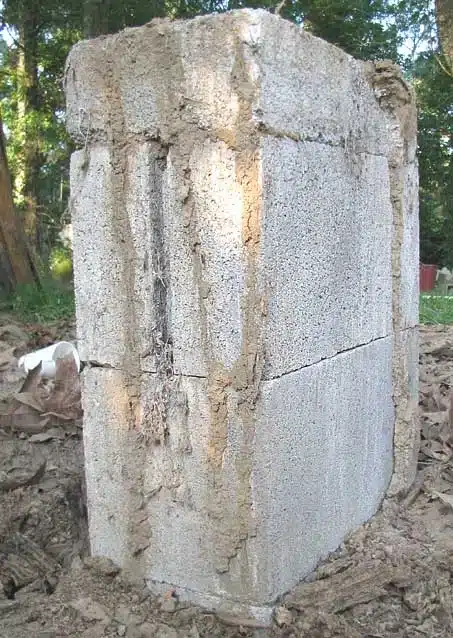Have you ever noticed small, brown earthen tunnels attached to your home’s foundation? These mysterious structures are called termite mud tubes, and they’re one of the most reliable signs that subterranean termites may be targeting your property. Understanding what these tubes mean and how to respond can save you thousands of dollars in damage and repairs.
I remember one inspection in Alexandria that really drove home how subtle termite activity can be. The homeowners called because they noticed a small bulge in their window sill where an addition had been built. When we investigated, we discovered termites had eaten right up to the paint and were about to break through. The real shock came when we checked the crawl space - termite mud tubes were running up the foundation walls, and it was clear termites had been feeding there for years. The damage was significant and costly to repair, all because these warning signs had gone unnoticed.
What Are Termite Mud Tubes?
Termite mud tubes are narrow tunnels that subterranean termites build between their underground colonies and food sources in your home. These protective highways allow termites to travel safely from soil to wood without exposing themselves to air, predators, or light.
Basically, these tubes serve three critical functions for termite survival. They maintain the high humidity levels termites need to avoid drying out, protect soft-bodied workers from predators like ants, and shield them from harmful UV light. Additionally, the earthen walls help moderate temperature swings that could stress the colony.
What does the science say?
The University of Florida’s termite research shows that termite mud tubes maintain nearly 98% humidity inside, compared to typical outdoor humidity of 30-60%. This moisture control is essential because termites will die quickly if exposed to dry air.
Learn more about termite tunnels and their structure in our detailed guide.
Appearance and Physical Characteristics of Termite Mud Tubes
Most termite mud tubes are about pencil-width, typically measuring 3-6 millimeters in diameter. However, heavy termite traffic can widen tubes to several centimeters across. The color usually matches your local soil and appears darker when moist.
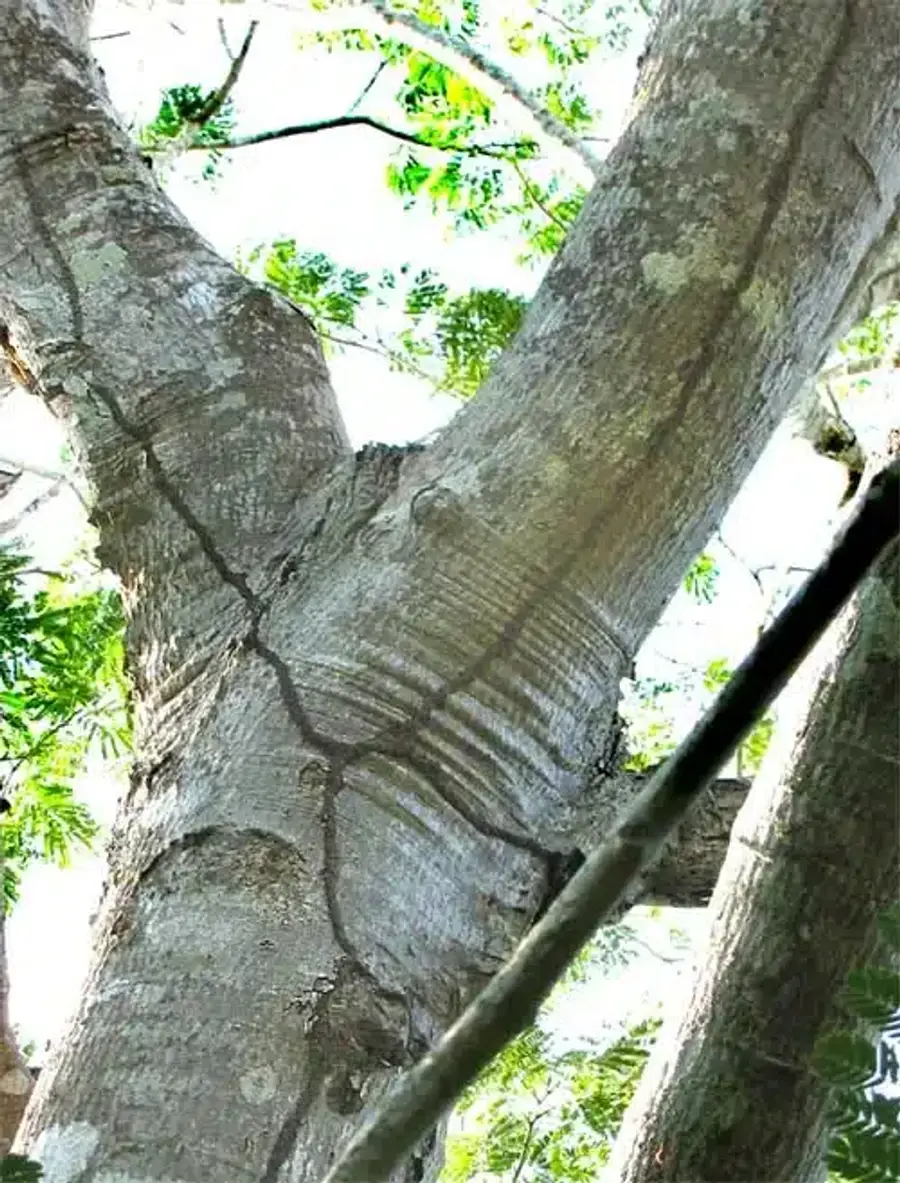

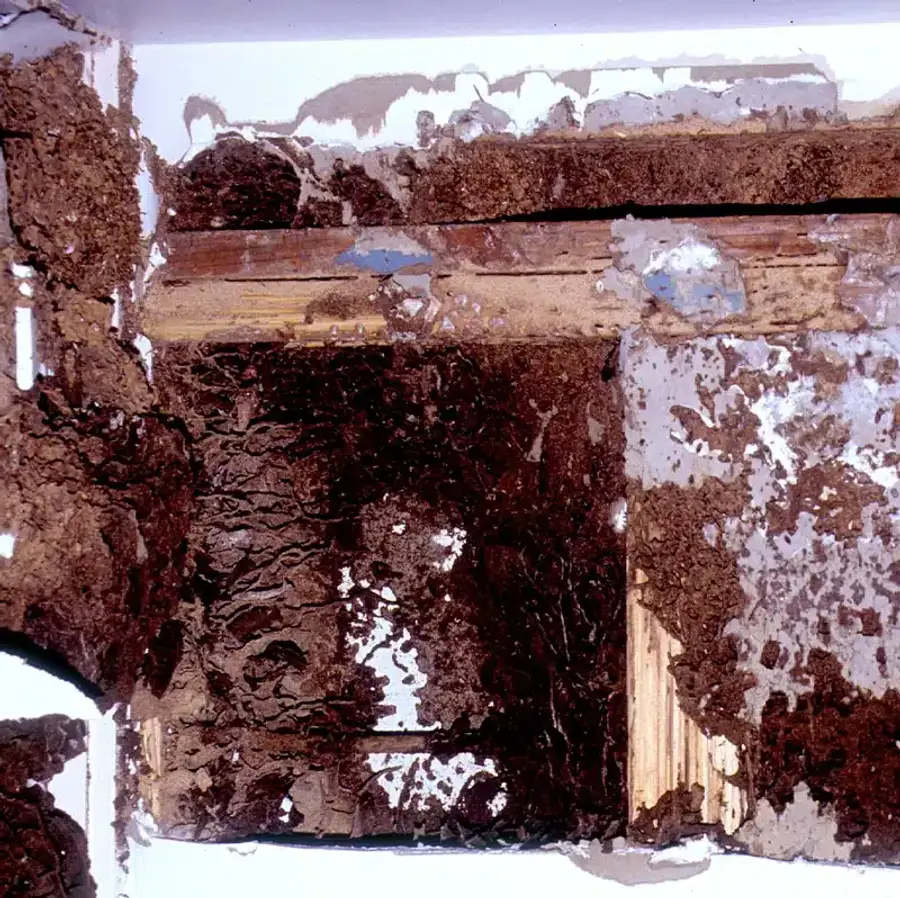
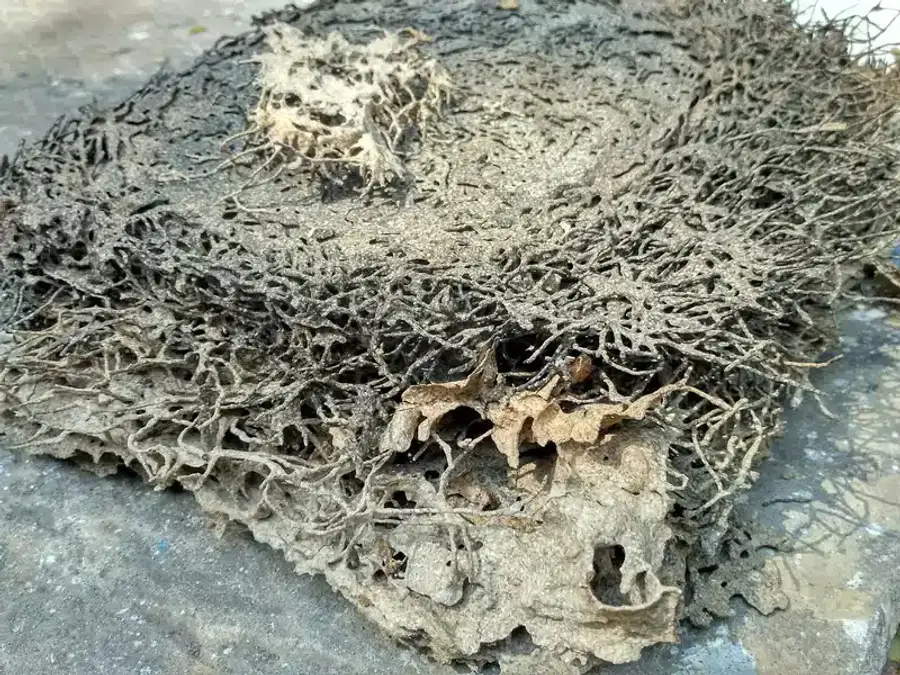
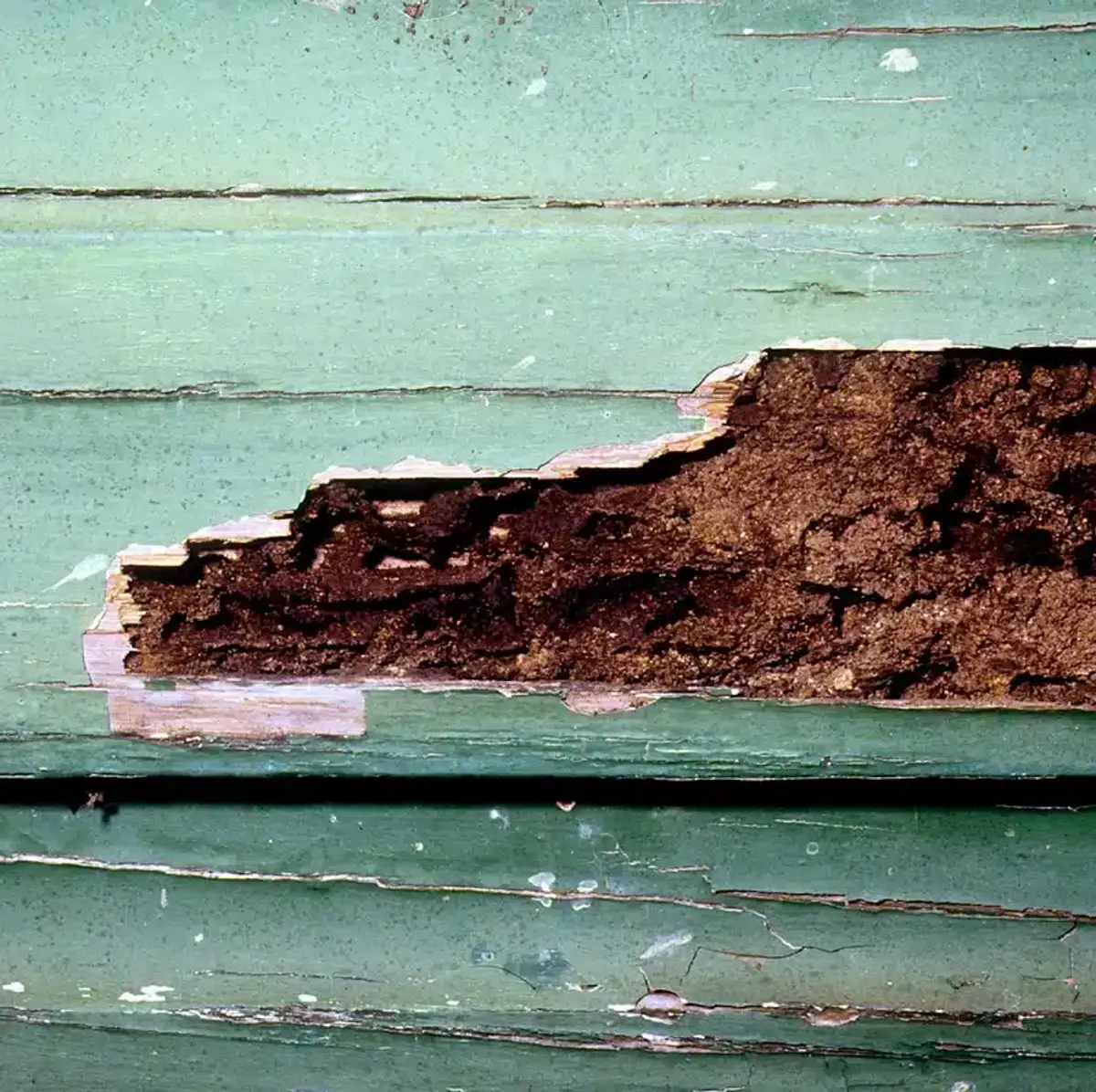
If you break open an active tube, you might see distinct “traffic lanes” where workers move up and down. These highways are constructed from a mixture of soil particles, chewed wood fibers, termite saliva, and fecal material. The saliva acts like cement, binding everything together into a durable tunnel.
The exterior texture feels rough and earthy, while the interior walls are smooth and often have a slight sheen from termite secretions. Fresh tubes appear moist and pliable, while older or abandoned ones become dry and brittle.
Understanding what termites look like can help you identify these pests if you spot them while examining mud tubes.
Common Locations for Termite Mud Tubes
Termite mud tubes appear in predictable locations around your home. Outside, check your foundation walls, crawl space entrances, porch supports, and areas where utilities enter your home. Pay special attention to spots where mulch touches your siding or where soil comes within six inches of wood.
Inside your home, termite mud tubes often hide in less obvious places. Look behind baseboards, inside hollow concrete block walls, around plumbing penetrations, and in unfinished basement areas. These interior tubes can go undetected for years because they’re hidden from view.
Don’t forget about aerial or “drop” tubes that hang down from wooden structures like stalactites. These form when termites establish feeding sites above ground level, often due to moisture problems like roof leaks or poor ventilation.
Regular inspections help identify termite infestations before they cause serious damage.
Types of Termite Mud Tubes
Working (Utility) Tubes
Working tubes are the main highways between soil and food sources. These are typically the widest and most active termite mud tubes, often showing clear traffic lanes inside. You’ll usually find these attached to both foundation walls and wooden structures.
Exploratory (Migratory) Tubes
Exploratory tubes are thinner and more fragile than working tubes. Termites build these while searching for food sources, and they often dead-end without reaching wood. These tubes can extend surprisingly far - sometimes 15 feet vertically up foundation walls.
Drop Tubes
Drop tubes hang down from wooden structures back to soil or other parts of the foundation. These suspended termite mud tubes indicate that termites have already established feeding sites in the wood above and are maintaining their connection to the soil colony.
Swarm-Castle Tubes
These temporary structures appear during termite swarming season, typically from late March through June in our area. Swarm tubes are shorter-lived and designed to help reproductive termites (alates) emerge from the colony to start new infestations.
Active vs. Inactive Mud Tubes: How to Identify Activity
Determining whether termite mud tubes are active requires a simple field test. Break a one-inch window in the tube and look immediately for live termites. You might see cream-colored workers or darker-headed soldiers scurrying for cover.
Check back in 24-72 hours to see if the termites have rebuilt or plastered over the break. Fresh repair work confirms active termite mud tubes. Look for moist interior walls and fresh fecal smears as additional signs of current activity.
However, empty tubes don’t guarantee the infestation is over. Termites frequently abandon and reuse tunnels based on seasonal patterns and food availability. Even inactive termite mud tubes indicate that termites have found your property attractive and may return.
Professional inspection helps identify active termite presence throughout your property, not just in obvious mud tube locations.
Why Termites Build Mud Tubes: The Science Explained
Termites are essentially aquatic insects that adapted to live on land, which explains their absolute dependence on moisture. Without protective tunnels, worker termites would dry out and die within hours when exposed to normal air humidity.
What does the science say?
Research from the University of California’s Integrated Pest Management Program confirms that termite mud tubes create a controlled microenvironment that maintains the high humidity levels termites need to survive. The earthen walls also provide insulation against temperature extremes.
Beyond moisture control, these tubes protect termites from their natural enemies. Ants are particularly effective termite predators, but they can’t easily penetrate these earthen fortresses. The tubes also block ultraviolet light that can harm termites.
Understanding what termites eat helps explain why they invest so much energy in building these protective highways to reach wood in your home.
Following Mud Tubes to Locate the Colony
When you discover termite mud tubes, tracing them can reveal important information about the infestation. Follow tubes downward to find where they enter the soil - this is likely near the main colony or major foraging galleries.
For slab foundations, trace tubes upward and along the foundation to locate hidden entry points through cracks or expansion joints. Document these findings with photos and mark locations on a simple floor plan sketch.
Use a long screwdriver to probe soil immediately adjacent to where tubes enter the ground. You might discover additional tunnels or even encounter live termites in the soil. This information helps professionals understand the scope of activity.
Understanding how termites spread throughout neighborhoods can help you assess whether nearby properties might also be at risk.
Documenting Mud Tubes in Inspection Reports
Professional termite inspections in Virginia, Maryland, and DC must document termite mud tubes according to specific standards. Licensed technicians note the location, whether tubes appear active or inactive, which areas were accessible for inspection, and any obstructions encountered.
Proper documentation includes photographs and detailed written descriptions like “active shelter tubes on interior west foundation wall, 3 feet left of crawl space access.” This level of detail helps track changes over time and guides treatment decisions.
These reports follow NPMA-33 or state WDI/WDO forms required for real estate transactions. The documentation helps buyers, sellers, and mortgage companies understand the termite situation before finalizing property transfers.
Immediate Actions Upon Discovery of Termite Mud Tubes
Why Removing Mud Tubes Alone Doesn’t Eliminate Termites
Simply scraping away termite mud tubes is like removing the symptoms while ignoring the disease. More than 90% of the termite colony remains safely underground, and they’ll quickly build alternate routes to reach the same food sources.
Termite mud tubes are diagnostic tools that help professionals understand colony behavior and plan effective treatments. Removing them prematurely can actually mask ongoing activity and make it harder to determine if treatments are working.
Professional treatment targets the entire colony system, not just the visible tunnels. Learn about proven methods to eliminate termites that address both the underground colony and above-ground feeding sites.
DIY vs. Professional Assessment for Termite Mud Tubes
While homeowners can certainly identify and monitor termite mud tubes, effective treatment typically requires professional intervention. EPA regulations restrict most termiticide soil treatments to licensed applicators who understand proper application rates and safety procedures.
The technical challenges of termite treatment include determining correct chemical volumes, drilling concrete slabs if necessary, and accessing hidden areas where termites might be active. Block foundations and finished basements add complexity that requires specialized knowledge.
Professional inspection provides several advantages. Licensed technicians know exactly where to look for hidden termite activity, understand local termite behavior patterns, and can provide ongoing monitoring through annual inspections. Many also offer warranty coverage that protects your investment.
Expert termite elimination methods typically involve comprehensive treatment strategies that DIY approaches can’t match.
Regional Context for Termite Mud Tubes in the Mid-Atlantic
Our area ranks as the second-highest region for termite activity in the United States. The dominant species - Eastern subterranean termites (Reticulitermes flavipes and R. virginicus) - are particularly well-adapted to our climate and soil conditions.
Termite swarming typically peaks from late March through May in Virginia and early April through June in Maryland. During these periods, you’re most likely to discover new termite mud tubes as colonies expand their foraging territory.
The clay-heavy soils common in our region retain moisture well, which termites love. Combined with our humid summers and the prevalence of crawl-space construction from the 1950s-1980s, conditions are ideal for subterranean termite activity.
What does the science say?
According to the University of Kentucky Extension, winter soil temperatures in our region rarely get cold enough to kill termite colonies, meaning they remain active year-round.
Integrated Response Options for Termite Mud Tube Infestations
Modern termite treatment addresses both immediate elimination and long-term prevention. Liquid barrier treatments create protective zones around your home’s foundation, while baiting systems like Sentricon target entire colonies at their source.
Borate wood treatments provide another layer of protection by making wooden structures toxic to termites. These treatments are particularly effective for new construction or renovation projects where wood is exposed.
Moisture control and structural modifications remove the conditions that attract termites in the first place. This might include improving drainage, increasing ventilation, or eliminating wood-to-soil contact areas around your property.
Preventing Termite Mud Tubes Through Maintenance and Inspections
Annual termite inspections are essential in our high-risk region. Professional technicians can spot early signs of activity before termite mud tubes become obvious, potentially saving thousands in damage costs.
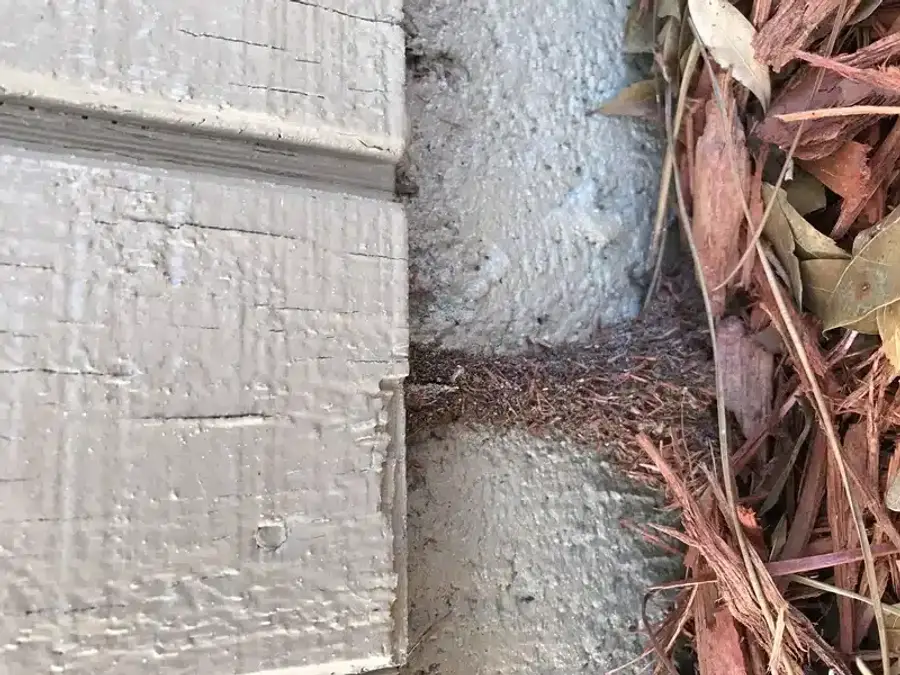
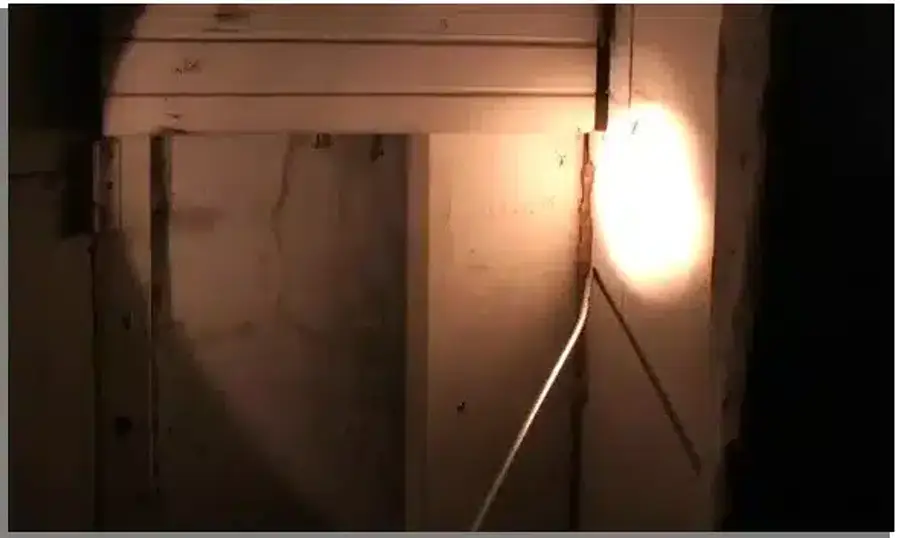
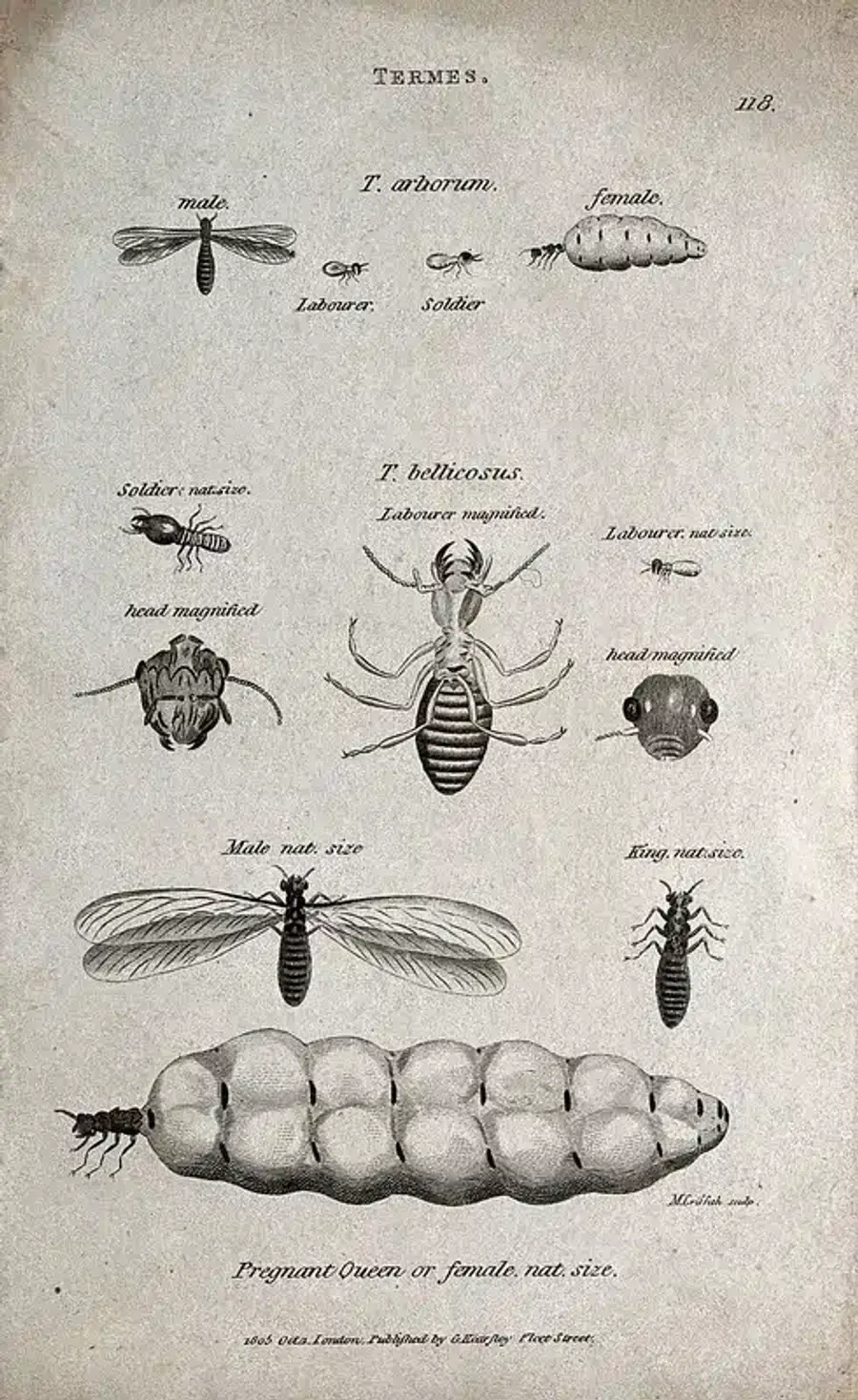
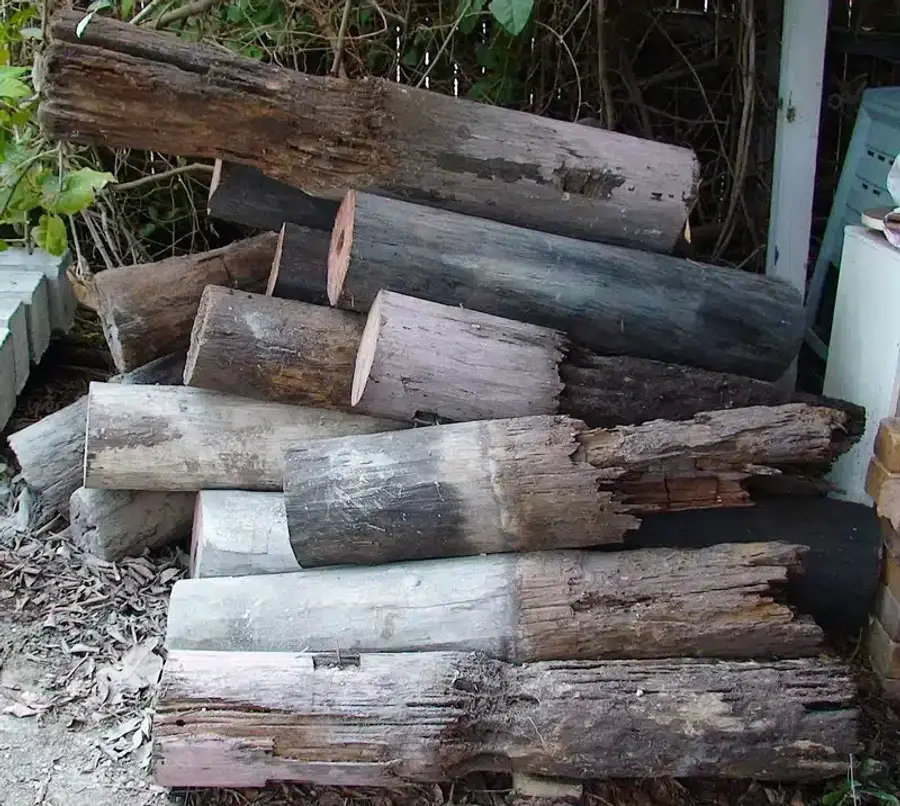
Remove conducive conditions that encourage termite activity. Keep mulch at least 6 inches from your foundation, eliminate wood-to-soil contact, store firewood away from your house, and address moisture problems promptly.
Maintain clear access to crawl spaces and basements so annual inspections can be thorough. Stored items that prevent complete examination create blind spots where termites can work undetected for years.
Understanding the importance of annual termite inspections helps homeowners stay ahead of potential problems.
Effective termite prevention strategies focus on making your property less attractive to termites while maintaining vigilant monitoring for early signs of activity.
Differentiating Termite Mud Tubes from Other Structures
Not every earthen tube indicates termite activity. Mud dauber wasps create similar-looking structures, but their tubes are typically smoother and don’t connect soil to wood. Root masses can also create tube-like formations, especially around plumbing leaks.
True termite mud tubes have distinctive characteristics that set them apart. They contain a mixture of soil and organic matter, show evidence of termite traffic patterns inside, and maintain specific moisture levels. The tubes always provide a protected pathway between soil and cellulose food sources.
When in doubt, professional identification prevents unnecessary worry about harmless structures while ensuring real threats don’t go unaddressed. Experienced technicians can quickly distinguish between termite signs and other common household issues.
Key Terms Related to Termite Mud Tubes
Understanding termite terminology helps homeowners communicate effectively with pest control professionals:
- Shelter tube: Another name for mud tubes that emphasizes their protective function
- Utility tube: The main highways termites use for regular traffic between colony and food
- Alates: Winged reproductive termites that emerge during swarming season
- Aerial colony: Above-ground termite nests that can develop in persistently moist conditions
- WDI/WDO report: Wood Destroying Insect/Wood Destroying Organism inspection report required for real estate transactions
- NPMA-33: Standard inspection form used throughout the pest control industry
Regular professional inspection and proper documentation help protect your property investment.
Frequently Asked Questions About Termite Mud Tubes
Need answers right now? The FAQ section below gathers the most common questions we hear when homeowners spot mud tubes.
What do termite mud tubes look like?
+
Termite mud tubes appear as brown, pencil-width earthen tunnels attached to foundation walls and wooden structures. They're typically 3-6 millimeters wide and have a rough, earthy texture on the outside with smooth interior walls. The color matches your local soil and appears darker when moist.
How do I know if termite mud tubes are active?
+
Break a small window in the tube and look for live termites immediately - you might see cream-colored workers or soldiers with darker heads. Check back in 24-72 hours to see if termites have repaired the break. Fresh plastering or rebuilt sections indicate active tubes.
Can I remove termite mud tubes myself?
+
While you can physically remove the tubes, this won't eliminate the termite problem. Over 90% of the colony remains underground and will simply build new tubes. Professional treatment is necessary to target the entire colony and prevent reinfestation.
Where are termite mud tubes most commonly found?
+
Look for termite mud tubes on foundation walls, in crawl spaces, around utility penetrations, and behind baseboards. They often appear where mulch meets your home's siding or anywhere soil comes within six inches of wood structures.
Do termite mud tubes always indicate a serious infestation?
+
Termite mud tubes signal subterranean termite activity, but the severity depends on factors like tube size, activity level, and how long termites have been present. Even small or inactive tubes warrant professional inspection because termites often abandon and reuse tunnels.
How quickly do termites build mud tubes?
+
Termites can construct mud tubes relatively quickly once they locate a food source. Working tubes may develop within days or weeks, while exploratory tubes can appear overnight as termites search for new feeding opportunities.
What's the difference between termite mud tubes and ant trails?
+
Termite mud tubes are enclosed earthen tunnels connecting soil to wood, while ant trails are typically open pathways along surfaces. Termite tubes maintain high internal humidity and contain a mixture of soil, wood particles, and termite secretions that ants don't produce.
Should I be concerned about termite mud tubes in my crawl space?
+
Yes, termite mud tubes in crawl spaces require immediate professional attention. Crawl spaces often provide ideal conditions for termite activity, and damage can occur for years before detection because these areas aren't regularly inspected.
Can termite mud tubes appear inside walls?
+
Termite mud tubes can develop inside wall voids, hollow concrete blocks, and other hidden spaces. These interior tubes are particularly concerning because they're harder to detect and may indicate extensive activity within your home's structure.
How long do termite mud tubes last?
+
Termite mud tubes can persist for months or years depending on environmental conditions and colony activity. Even abandoned tubes may remain structurally intact long after termites have moved to other areas, which is why professional assessment of tube activity is essential.
With five years of hands-on experience in the pest control industry, George Schulz is a registered technician with the Virginia Pest Management Association and a proud third-generation professional in a family business that's been protecting homes for over 57 years. He manages and trains a team of service pros while also leading internal research efforts—recently spearheading a deep-dive review of thousands of documents on pest control materials to hand-pick the most kid and pet friendly, most effective solutions tailored specifically for homes in the DC metro area.
